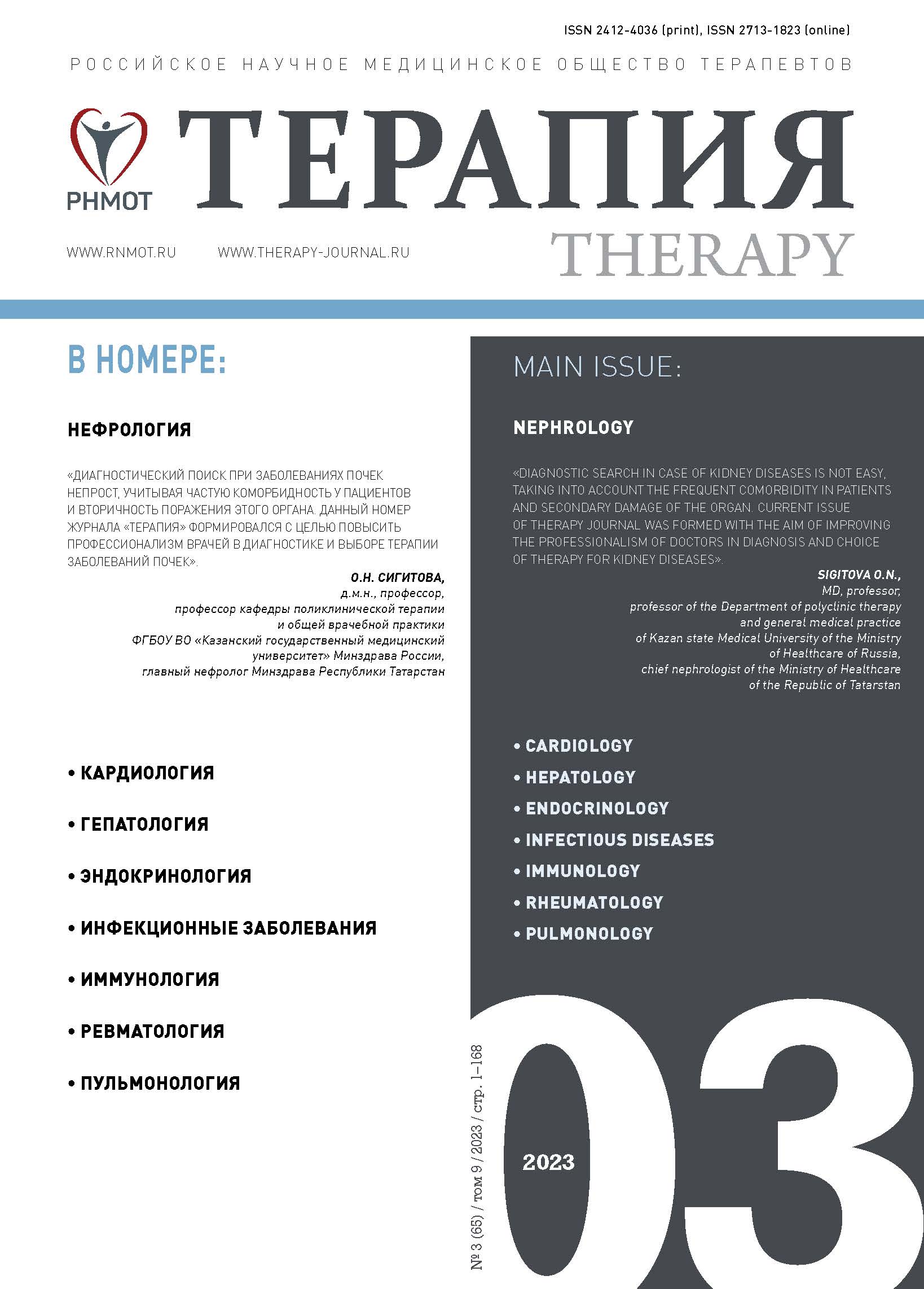Tubulointersticial nephritis
- 作者: Batyushin M.M.1, Zakusilov D.I.1, Sigitova O.N.2,3
-
隶属关系:
- Rostov State Medical University of the Ministry of Healthcare of Russia
- Kazan State Medical University of the Ministry of Healthcare of Russia
- Kazan State Medical Academy – a branch of Russian Medical Academy of Continuous Professional Education of the Ministry of Healthcare of Russia
- 期: 卷 9, 编号 3 (2023)
- 页面: 114-120
- 栏目: LECTURES & REPORTS
- URL: https://journals.eco-vector.com/2412-4036/article/view/516350
- DOI: https://doi.org/10.18565/therapy.2023.3.114–120
- ID: 516350
如何引用文章
详细
Chronic tubulointerstitial nephritis (CTIN) is a chronic kidney disease that develops in response to long-term exposure to exogenous and /or endogenous factors and is manifested by inflammatory changes in tubulointerstitial tissue with the formation of interstitial fibrosis and tubular atrophy accompanied by frequent development of chronic kidney disease. In clinical practice, TIN often occurs as an acquired form, mainly due to medicamentous exposure or infectious inflammation of renal tissue (pyelonephritis). The article contains issues related to the etiology, pathogenesis, clinic and diagnosis of CTIN. Approaches to the treatment of CTIN patients are given, taking into account their individual etiopathogenetic characteristics. The article has a form of a brief abstract on STIN problem for primary care physician help.
全文:
作者简介
Mikhail Batyushin
Rostov State Medical University of the Ministry of Healthcare of Russia
编辑信件的主要联系方式.
Email: batjushin-m@rambler.ru
ORCID iD: 0000-0002-5329-7050
MD, Professor, Professor of the Department of Internal Medicine No. 2
俄罗斯联邦, Rostov-on-DonDmitry Zakusilov
Rostov State Medical University of the Ministry of Healthcare of Russia
Email: batjushin-m@rambler.ru
ORCID iD: 0000-0002-6455-9204
Assistant at the Department of Medical Rehabilitation, Sports Medicine, Physical Education with a Course of Medical and Social Expertise
俄罗斯联邦, Rostov-on-DonOlga Sigitova
Kazan State Medical University of the Ministry of Healthcare of Russia; Kazan State Medical Academy – a branch of Russian Medical Academy of Continuous Professional Education of the Ministry of Healthcare of Russia
Email: osigit@rambler.ru
ORCID iD: 0000-0001-8983-245X
MD, Professor of the Department of Polyclinic Therapy and General Medical Practice, Kazan State Medical University of the Ministry of Healthcare of Russia, Professor of the Department of Urology of Kazan State Medical Academy – a branch of Russian Medical Academy of Continuous Professional Education of the Ministry of Healthcare of Russia
俄罗斯联邦, Kazan; Kazan参考
- Тубулоинтерстициальные болезни почек. Проект клинических рекомендаций. Ассоциация нефрологов. Доступ: https://rusnephrology.org/wp-content/uploads/2021/09/tubulointerstitial.pdf (дата обращения – 01.04.2023). [Tubulointerstitial kidney diseases. Draft clinical recommendations. Association of Nephrologists. URL: https://rusnephrology.org/wp-content/uploads/2021/09/tubulointerstitial.pdf (date of access – 01.04.2023) (In Russ.)].
- Baker R.J., Pusey C.D. The changing profile of acute tubulointerstitial nephritis. Nephrol Dial Transplant. 2004; 19(1): 8–11. https://dx.doi.org/10.1093/ndt/gfg464.
- Nakaosa N., Tsuboi N., Okabayashi Y. et al. Tubulointerstitial nephritis: a biopsy case series of 139 Japanese patients. Clin Exp Nephrol. 2022; 26(5): 435–44. https://dx.doi.org/10.1007/s10157-021-02178-6.
- Fernandez Juarez G.M., Villacorta Perez J., Caravaca Fontan F. et al. New challenges in tubulointerstitial nephritis induced by drugs. Nefrologia (Engl Ed). 2019; 39(4): 339–42. https://dx.doi.org/10.1016/j.nefro.2019.02.003.
- Kan W.C., Chen Y.C., Wu V.C., Shiao C.C. Vancomycin-associated acute kidney injury: A narrative review from pathophysiology to clinical application. Int J Mol Sci. 2022; 23(4): 2052. https://dx.doi.org/10.3390/ijms23042052.
- Bhandari J., Thada P.K., Arif H. Tubulointerstitial nephritis. 2022 Nov 20. In: StatPearls [Internet]. Treasure Island (FL): StatPearls Publishing; 2022 Jan. PMID: 32491469.
- Eddy A.A. Drug-induced tubulointerstitial nephritis: hypersensitivity and necroinflammatory pathways. Pediatr Nephrol. 2020; 35(4): 547–54. https://dx.doi.org/10.1007/s00467-019-04207-9.
- Eckardt K.U., Alper S.L., Antignac C. et al. Autosomal dominant tubulointerstitial kidney disease: diagnosis, classification, and management – A KDIGO consensus report. Kidney Int. 2015; 88(4): 676–83. https://dx.doi.org/10.1038/ki.2015.28.
- Cavanaugh C., Perazella M.A. Urine sediment examination in the diagnosis and management of kidney disease: Core curriculum 2019. Am J Kidney Dis. 2019; 73(2): 258–72. https://dx.doi.org/10.1053/j.ajkd.2018.07.012.
- Ramos G.K., Goldfarb D.S. Update on uric acid and the kidney. Curr Rheumatol Rep. 2022; 24(5): 132–38. https://dx.doi.org/10.1007/s11926-022-01069-3.
- Drawz P.E., Beddhu S., Bignall O.N.R. 2nd et al. KDOQI US commentary on the 2021 KDIGO clinical practice guideline for the management of blood pressure in CKD. Am J Kidney Dis. 2022; 79(3): 311–27. https://dx.doi.org/10.1053/j.ajkd.2021.09.013.
- Wheeler D.C., Stefansson B.V., Batiushin M. et al. The dapagliflozin and prevention of adverse outcomes in chronic kidney disease (DAPA-CKD) trial: baseline characteristics. Nephrol Dial Transplant. 2020; 35(10): 1700–11. https://dx.doi.org/10.1093/ndt/gfaa234.
- Palmer B.F., Clegg D.J. Kidney-protective effects of SGLT2 inhibitors. Clin J Am Soc Nephrol. 2023; 18(2): 279–89. https://dx.doi.org/10.2215/CJN.09380822.
- Ikizler T.A., Cuppari L. The 2020 Updated KDOQI clinical practice guidelines for nutrition in chronic kidney disease. Blood Purif. 2021; 50(4–5): 667–71. https://dx.doi.org/10.1159/000513698.
- Клинические рекомендации. Хронический пиелонефрит у взрослых. Российское общество урологов. 2016. Доступ: https://antimicrob.net/wp-content/uploads/2016____-Rekom.-Ross.obshhestva-urologov_KHronicheskii%CC%86-pielonefrit-u-vzroslykh.pdf (дата обращения – 01.04.2023). [Clinical guidelines. Chronic pyelonephritis in adults. Russian Society of Urologists. 2016. URL: https://antimicrob.net/wp-content/uploads/2016____-Rekom.-Ross.obshhestva-urologov_KHronicheskii%CC%86-pielonefrit-u-vzroslykh.pdf (date of access – 01.04.2023) (In Russ.)].
补充文件







